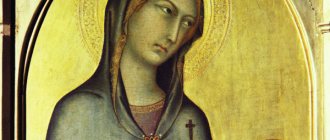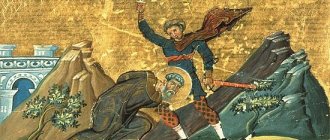LAVRENTY
In the IV-V centuries. a legend arose about L., later. forming the basis of hagiographical tales, which in the Middle Ages and Modern times remained the most important sources of information about the martyr. The earliest version of this legend was given by St. Ambrose of Milan in his treatise “On the Duties of the Clergy” (c. 388). Discussing the behavior of the ministers of the Church and the proper use of church property, Ambrose pointed to the feat of L., who gave Christians an example of courage and fortitude (fortitudo) in the face of torture and death. The guards grabbed Sixtus II and took him to execution. Seeing L. crying, the bishop predicted that he was destined to suffer a painful death in 3 days (about this dialogue, see: Lanéry. 2006). At the request of the persecutors, L. agreed to give them the treasures of the Roman Church, but instead distributed the valuables to the poor. The next day, when he was demanded to fulfill his promise, the deacon pointed to the poor and declared that they were the treasure of the Church. According to Ambrose, for his exceptional wit (pro singulari suae interpretationis vivacitate), L. was subjected to a cruel execution: the “deceived tyrant” ordered him to be roasted alive on an iron grate (craticula). Overcoming the pain, the deacon exclaimed: “Ready, turn over and taste” (Assum est, inquit, uersa et manduca) (Ambros. Mediol. De offic. I 41; II 28 // PL. 16. Col. 84-86, 141- 142). Ambrose cited these words of L. addressed to the executioner as an example of fortitude and contempt for death in a letter to the Venerable. Simplician (Bishop Mediolanus in 397-400/1) (Idem. Ep. 37 (54). 36-37 // PL. 16. Col. 1093).
Archdeacon. sschmch. Lawrence accepts the treasures of the Church from Pope Sixtus II and distributes alms. Painting of the chapel of Pope Nicholas V in the Papal Palace in the Vatican. Artist Fra Angelico. OK. 1447–1450 Archdeacon. sschmch. Lawrence accepts the treasures of the Church from Pope Sixtus II and distributes alms. Painting of the chapel of Pope Nicholas V in the Papal Palace in the Vatican. Artist Fra Angelico. OK. 1447–1450
Archdeacon. sschmch. Lawrence accepts the treasures of the Church from Pope Sixtus II and distributes alms. Painting of the chapel of Pope Nicholas V in the Papal Palace in the Vatican. Artist Fra Angelico. OK. 1447–1450
Archdeacon. sschmch. Lawrence accepts the treasures of the Church from Pope Sixtus II and distributes alms. Painting of the chapel of Pope Nicholas V in the Papal Palace in the Vatican. Artist Fra Angelico. OK. 1447–1450
In the hymn "Apostolorum supparem", composed either by St. Ambrose, or someone from his entourage, also reported on the prediction of Sixtus II and that the persecutors ordered L. to hand over the church treasury. Pretending that he agreed to carry out the order, the deacon brought poor Christians, whom he called “the property of the Church.” The greedy official flew into a rage and ordered L. to be put to slow death by fire. During the execution, the flame burned the executioner, and the dying martyr said: “Turn me over and devour me if I am fried” (Versate me, martyr uocat, / uorate, si coctum est, iubet - PL. 17. Col. 1216-1217; Early Latin Hymns / Ed. AS Walpole. Camb., 1922. P. 97-104; see: Jullien. 1989; Nauroy. 1989; Benvenuti, Giannarelli. 1998. P. 27-35).
The legend of L.'s martyrdom is set out in the poem by Prudentius from the cycle “The Crowns of the Martyrs” (Prudent. Perist. 2). The poet gives details that are absent from St. Ambrose. The persecutors crucified Sixtus II, and L. wept at the foot of the cross. The bloodthirsty prefect of Rome demanded that the deacon hand over valuables allegedly needed by the treasury. Recognizing that the Church had enormous wealth at its disposal, L. promised to give “that dear thing that Christ has” and received a 3-day reprieve. Gathering all the needy, sick and crippled Christians, he showed the prefect the square filled with people. The poet put into L.’s mouth a speech that the true treasure of Christ is people with a pure soul; Unlike healthy and rich pagans, these people are poor and ugly, but spiritual beauty is hidden behind their physical ugliness, therefore they are a true adornment of the Church. Before his death, L. prayed that the Romans would believe in Christ and free themselves from slavish service to idols. Prudentius attributes to the martyr a prophecy about the triumph of Christ. faith in the Roman Empire.
In the epic poem Prudentius L. is presented as a Christ. a hero who “destroyed death by death.” The death of the martyr marked the collapse of paganism: thanks to his feat, Rome, enslaved by superstition, regained its freedom (Laurentio uictrix duce / ritum triumfas barbarum) (according to Ambrose, the martyr led the Romans in their triumph over pagan errors). L.'s feat was not only a symbol of the victory of Christianity over paganism, but also an example of heroic virtue. If St. Ambrose argued that the martyr's devotion to Christ was stronger than the friendship of Orestes and Pylades, the ancient Greek heroes. tragedies, then Prudentius described L. as a “new Aeneas” who surpassed ancient Rome. heroes (Buchheit. 1971). The suffering of the martyr in the poem is given less attention than the moralizing opposition of Christ. virtues to pagan vices. At the same time, Prudentius endowed the image of L., created by him, with the features of a trickster: having played a joke on the greedy prefect, the martyr provoked him to cruelty and, having accepted death, won a victory over paganism. If the ancient heroes were portrayed as stern, courageous people, then Prudentius used playful erotic allusions (in the description of the execution of L.) and ambiguous allegories, speaking of the “fatherly love” of the martyr for the Romans, contained in his “mammalian breast” (...tuosque alumnos urbicos / lactante complexus sinu / paterno amore nutrias) (see: Conybeare. 2002). However, the teaching about vices and virtues, put by the poet into L.’s mouth, corresponded to ideas about traditions. Rome. values, and the heroic death of the martyr was a feat that overshadowed the deeds of the heroes of Dr. Rome. Thus, Prudentius sought to demonstrate that Christ. the morality and exploits of the martyrs surpassed Roman ideas about virtue, although they did not contradict them (see: Benvenuti, Giannarelli. 1998. P. 35-44; Fux. 2003).
Archdeacon. sschmch. Lawrence with Christians before the Prefect of Rome. Painting of the Cathedral of Genoa. Artist L. Tavarone. 1622
Archdeacon. sschmch. Lawrence with Christians before the Prefect of Rome. Painting of the Cathedral of Genoa. Artist L. Tavarone. 1622
Preachers also turned to L.’s feat, including Blessed. Augustine. In Carthage and Hippo (now Annaba, Algeria), Augustine preached at least 7 sermons on the day of memory of L. Most often, the preacher pointed to the feat of the martyr as an example for all Christians, spoke about the need to honor the saints and imitate their virtues (Aug. Serm. 302 -305A; Idem. In Ioan. XXVII 12; see: Benvenuti, Giannarelli. 1998. P. 46-54). In Italy St. Maxim Taurinsky dedicated 2 sermons to L.’s fiery faith and his ardent love for Christ, likening the martyr to a mustard seed from the Gospel parable (Matthew 13.31-32; Mark 4.30-32; Luke 13.18-19) (Maxim. Taurin. Serm. 4, 24). In the sermon of St. Leo I the Great, Pope of Rome, also speaks of the martyr’s firmness and his love for Christ; like Prudentius, the pontiff compared L. with the First Man. Stefan (Leo Magn. Serm. 72 (85)). Among the works of Maxim Tavrinsky, 5 sermons have been preserved on the day of memory of L., which in the present day. time are considered inauthentic (PL. 57. Col. 407-414, 677-679, 681-682). St. Peter Chrysologus was previously credited with preaching a brief retelling of the legend of the martyrdom of L. (PL. 52. Col. 565-567). Apparently, these homilies were compiled in the 5th-6th centuries, most likely in Italy. Blzh. Augustine, St. Maxim, St. Leo the Great and other preachers relied mainly on the treatise of St. Ambrose “On the duties of the clergy” and the hymn “Apostolorum supparem” (see: Nauroy. 1989. P. 60-78; Benvenuti, Giannarelli. 1998. P. 54-64).
The earliest hagiographic work that describes the feat of L. is the Martyrdom of Sixtus, L. and Hippolytus, or “Passio vetus”, compiled no earlier than the middle. V century The author of the text was most likely a cleric who served in Rome. Basilica of San Lorenzo Fuori le Mura (Verrando. 1990. P. 178-179; ed.: Idem. 1991). Apparently, before the creation of “Passio vetus”, oral stories about the martyr were widespread, which were used by Ambrose, Prudentius and other early authors, supplementing them with fictitious details (Lanéry. 2006. P. 60; cp.: Nauroy. 1989. P. 45). The text of “Passio vetus” has a complex history: numerous manuscripts (J. N. Verrando’s edition includes 36 manuscripts created no later than the 13th century) contain both individual parts and contaminated versions of the legend. According to Verrando, the original edition of the Passio vetus has not survived; closest to it is the version presented in one of the early Carolingian legendaries (Monac. Clm. 4554. Fol. 86r - 88r; turn of the 8th and 9th centuries, Benediktbeuern Abbey).
Martyrdom of the Archdeacon. Lawrence. Painting of the crypt of Sant'Epifanio in the monastery of San Vincenzo al Volturno. 824–842
Martyrdom of the Archdeacon. Lawrence. Painting of the crypt of Sant'Epifanio in the monastery of San Vincenzo al Volturno. 824–842
In "Passio vetus" the death of Sixtus II and L. is mistakenly associated with the rise to power of the emperor. Decius (249-251), presented as a cruel persecutor of Christians. Upon learning of Decius's imminent arrival in Rome, the bishop called on all Christians to prepare for martyrdom. To prevent church property from falling into the hands of the authorities, Sixtus II handed it over to the archdeacon. L., who sold valuables to Christians and distributed the money to the poor. Decius brought the Persians to Rome. Christians Abdon and Sennen, whom he tortured for refusing to renounce Christ and eventually killed. After Sixtus II, who refused to bow to the pagan gods, was beheaded, the emperor ordered L. to hand over the church treasures and gave him a 2-day reprieve. The military commander Hippolytus was assigned to monitor the archdeacon. Seeing that L. was collecting poor Christians, Ippolit suspected deception and ordered to show where the valuables were hidden. The archdeacon promised to give him countless treasures if he believed in Christ. Having witnessed how L. healed the blind, Hippolytus converted to Christianity. At the appointed time, the archdeacon came to the emperor along with many beggars, whom he called “the imperishable treasure of the Church.” By order of the angry Decius, the prefect of the city, Valerian, tortured the martyr in the palace of Tiberius. When they began to fry him on the grill, L. courageously endured suffering and gave up the ghost. Hippolytus secretly took his body and buried him in an underground crypt; Having learned about this, the emperor executed the military leader. On the 7th day after his death, during the ceremonial entry into the amphitheater, Decius and Valerian were punished for cruelty with sudden death.
An expanded version of the legend about L. is presented in the hagiographic novel known as the Martyrdom of Polychronia (BHL, N 4753; ed.: Delehaye. 1933). According to I. Delee, Martyrdom was created in Rome at the turn of the 5th and 6th centuries. (approx. 500 - Dufourcq. 1900. P. 309). It included tales about several. Rome. martyrs, including Sixtus II, L. and Hippolytus. The story of L. begins with the return to Rome of Decius, who allegedly seized power after the death of the emperor. Galba (68-69). With the help of Prefect Valerian, the new emperor began to brutally persecute Christians. Pope Sixtus II, captured by persecutors, predicted that L. would die in 3 days, and instructed him to take care of the treasures of the Church. Fulfilling the last will of the bishop, L. looked for poor Christians, distributed money to them and looked after them; He also healed the widow Kyriakou, who was sheltered by Christ. clerics from the persecutors, and the blind Crescention. In the meantime, Bishop Sixtus II and the deacons Felicissimus and Agapitus were condemned to death. When L. learned of the verdict, he exclaimed: “Do not leave me, holy father, because I have already disposed of the treasures that you gave me.” Hearing these words, the guards grabbed him and brought him to the tribune Parthenius, who reported to the emperor that L. had hidden church valuables. Wanting to take possession of the treasures, Decius ordered the prefect Valerian to find them, and he instructed the vicar Hippolytus to guard the archdeacon. In prison, L. healed the blind Lucillus and converted Hippolytus and his household to Christ. The prefect ordered the archdeacon to hand over the valuables in 3 days, and he took advantage of the delay to collect the poor and crippled. With the help of Hippolytus, the archdeacon brought them to the palace of Sallust, where the emperor was, and presented them as “the imperishable treasure of the Church.” They demanded that he renounce Christ, and after his refusal he was beaten and scourged. By order of Decius, the archdeacon was taken to the palace of Tiberius and his trial was held in the Basilica of Jupiter. There L. again refused to bow to idols and was again severely beaten (the text emphasizes that the persecutors first of all demanded that he renounce his faith; less attention is paid to the issue of treasures). Seeing the martyr’s fortitude, the guard Roman believed in Christ and was baptized, but was soon captured and executed. At night, the emperor and prefect held a trial in the Baths of Olympias near the Palace of Sallust, preparing many torture instruments. At the last interrogation, L. stated that he was a native of Spain, but grew up in Rome. By order of Decius, he was laid on an iron bed “like a lattice” and roasted over low heat. Despite the pain, the martyr continued to argue with the emperor, and he ordered him to be fried alive. Before his death, looking into Decius’s face, L. offered to turn him over and try the “roast.” At dawn, Hippolytus stole L.'s body and, together with the Rev. Justin, to whom he told about the sufferings of the martyr, buried him on the land of the widow of Kyriaki on the Tiburtine road. The following tells about the death of Hippolytus and other martyrs and about the punishment that befell Decius and Valerian.
Pope Sixtus II and Archdeacon. Lavrenty. Mosaic “Procession of Martyrs” in the c. Sant'Apollinare Nuovo in Ravenna. 1st half VI century
Pope Sixtus II and Archdeacon. Lavrenty. Mosaic “Procession of Martyrs” in the c. Sant'Apollinare Nuovo in Ravenna. 1st half VI century
In the Liber Pontificalis, in a brief biography of Pope Sixtus II, information about L. is given, which resembles the Martyrdom of Polychronius, but diverges from it in detail. It is stated here that L. suffered 3 days after the death of Sixtus II; the subdiacs were executed along with him. Claudius, Rev. Severus, reader Crescentius and ostiary Romanus. As in the hagiographical tales, the pontificate of Sixtus II is erroneously dated to the reign of the emperors Valerian and Decius (LP. T. 1. P. 155; see: Benvenuti, Giannarelli. 1998. P. 73-74).
The tales of L.'s martyrdom are largely legendary. The researchers pointed out “the complete lack of credibility in this whole story” (Serra. 2015. P. 37). According to Delehaye, L. most likely was a historical person, but reliable information about him cannot be distinguished from fictional ones (Delehaye. Légendes. P. 104). Anachronisms and factual errors contained in hagiographical tales show that Rome. hagiographers had little idea about the events of the Ser. III century The method of execution to which L. was subjected does not agree with reliable data about the persecution of Valerian (as a rule, martyrs’ heads were cut off; the only example of public execution by burning was the death of Bishop Fructuosus and 2 of his deacons in January 259 in Tarracona (now Tarragona, Spain)). Cruel torture and painful methods of execution began to be used against Christians only in the era of the tetrarchy (286-324) (Franchi de' Cavalieri. 1900; Delehaye. 1933. P. 49-50). P. Franchi de Cavalieri pointed out the similarities between the legend about the execution of L. and the legend about the Phrygian martyrs who died under the emperor. Julian the Apostate (361-363), which is cited by church historians Socrates Scholastic (Socr. Schol. Hist. eccl. III 15) and Sozomen (Sozom. Hist. eccl. V 11) (Franchi de' Cavalieri. 1915). Like L., these martyrs were roasted alive on an iron grate; During the execution, they courageously demanded that the executioners turn them over on the other side (Delee considered the analogy indicated by Franchi de Cavalieri with a replica of the Gallic martyr Attalus (Euseb. Hist. eccl. V 1. 52) to be insignificant). According to Delee, we are talking about lit. a motif that originated in the East and was borrowed from Western countries. by the authors who included it in the legend of L. (AnBoll. 1900. T. 19. P. 452-453; see also: Delehaye. Légendes. P. 97-98; Idem. 1933. P. 55-58). This assumption is not entirely convincing, because in the 80s. IV century the legend about the execution of L. was already known to Ambrose of Milan, and the testimonies of Socrates and Sozomen date back to a later time.
Based on early evidence, it is difficult to judge where and under what circumstances the legend about L. The statement of St. Ambrose that L. died 3 days after the execution of his bishop is consistent with Rome. liturgical tradition, in which the commemoration of Sixtus II took place on August 6, and L. - on August 10. Information about the method of execution of the martyr and about the demand of the persecutors to hand over treasures may be related to the so-called. the great persecution of Christians in the beginning. IV century, when the authorities confiscated church property. Dr. details could go back to secular literature. stories. Thus, the scene in which L. showed the persecutors of the poor, “the treasure of the Church,” was most likely inspired by the legend about the mother of the Gracchi, who, in response to a request to show the jewelry, brought her sons (Val. Max. Mem. IV 4; see .: Delehaye. 1933. P. 58). St. Ambrose, blessed Augustine and the authors of sermons called L. both deacon and archdeacon; according to Prudentius, the martyr was the eldest among the 7th Romans. regional deacons (hic primus a septem viris). The custom of calling the senior deacon of the Roman Church archdeacon is attested in the 2nd half. IV century (Gesta inter Liberium et Felicem // Coll. Avel. Pars 1. P. 1-2; see: Di Berardino A. Archdeacon // Encyclopedia of Ancient Christianity. Downers Grove (Ill.), 2014. Vol. 1. P 219).
Archdeacon. sschmch. Lavrenty. Fragment of the painting of Chapel No. 9 of San Lorenzo Fuori le Mura in Rome. Ser. XI century
Archdeacon. sschmch. Lavrenty. Fragment of the painting of Chapel No. 9 of San Lorenzo Fuori le Mura in Rome. Ser. XI century
Iconographic monuments do not allow us to trace the formation of the legend about the death of L. The earliest images of the martyr were preserved on medallions made by Rome. masters of the IV-V centuries. using the “gold glass” technique (a thin gold sheet with a cut-out image was placed between 2 layers of glass). On them, L. is presented without the attributes of martyrdom, usually together with the apostles Peter and Paul, Cyprian of Carthage, Sixtus II or Hippolytus (see: Morey Ch. R. The Gold-glass Collection of the Vatican Library / Ed. G. Ferrari. Vat., 1959. P. 10-11, 43, 49, 75). On the mosaics of the oratory at the c. The Holy Cross in Ravenna, known as the mausoleum of Galla Placidia (1st half of the 5th century), depicts a martyr with a processional cross and an open book, walking against the background of a lattice bed, under which a fire is blazing. It is generally accepted that this martyr is L., but other opinions have been expressed (see: Mauskopf Deliyannis. 2010. P. 78-79). On the fresco in the catacombs of San Senatore in Albano Laziale (late 5th century) L. is presented together with the apostles Peter and Paul standing before Christ and the martyr. Smaragd; in his hand he has a cross and a book. Thus, the earliest images of L. with attributes of martyrdom date back to the 5th century. (the scene of L.’s execution in the presence of the emperor was presented on the now lost bronze medallion of Sucess (IV century?), but the authenticity of the medallion remains in question; see: Leclercq. 1929. Col. 1926-1927; Serra. 2015. P. 50 -51). On the mosaic of the 6th century. in the Basilica of San Lorenzo Fuori le Mura, in the open book held by L., the text of Ps 111. 9 (Dispersit dedit pauperibus) is placed. This verse, indicating the duties of a deacon and the circumstances of L.’s death, was used in liturgical chants in honor of the martyr. The earliest depictions of L.'s execution date back to the Carolingian era, for example. fresco in the crypt of Abbot Epiphanius in the monastery of San Vincenzo al Volturno (2nd quarter of the 9th century) and a miniature in the Sacramentary of Drogon of Metz (mid 9th century) (Paris. lat. 9428. Fol. 89r) .
In the Middle Ages, various versions of the legend about L. became widespread in the West. The Martyr was often presented as an exemplary servant of the Church and its defender from the encroachments of greedy rulers. The relevance of this interpretation of the image of L. was associated with conflicts between Catholics. Church and secular monarchs. Numerous editions of the Martyrdom of L. are known (BHL, N 4753-4772), on which the legends about the martyr in the “historical” martyrologies of the Carolingian era are based. Thus, the most detailed legend in the martyrology of Adon of Vienne is an epitome of the corresponding chapters of the Martyrdom of Polychronius. Old English is also based on this source. version of the Martyrdom of L. as part of the 1st series of “Catholic Sermons” by Abbot Elfric (late 10th century; ed.: The Homilies of the Anglo-Saxon Church / Ed. B. Thorpe. L., 1844. Vol. 1. P. 416-437). A poetic adaptation of the legend about L. and other martyrs who suffered with him was included by Flodoard of Reims in the poem “The Victories of Christ in Italy” (PL. 135. Col. 685-688; see: Jacobsen P. Ch. Flodoard von Reims: Sein Leben und seine Dichtung "De triumphis Christi". Leiden, 1978. S. 252-253). Among Lat. metrical versions of the legend about L. - “Poems about St. Lawrence" Marboda, bishop. Rennes (PL. 171. Col. 1607-1614), “Martyrdom of St. Lawrence" by the Benedictine Nigel of Canterbury (Nigel of Canterbury. 1994) and the poem of William of Massenago (AnBoll. 1892. T. 11. P. 313, 318-320). Sermons, hymns and other writings about L. belong to the theologian, historian and hagiographer Regnier († 1188), who lived in the Abbey of St. L. in Liege. There are known tales about the martyr in national languages, for example, the Anglo-Norman poetic Life of L. (between 1140 and 1170 - La Vie de Saint Laurent. 1976), the Castilian poem by Gonzalo de Berceo “The Passion, or the Martyrdom of St. Lawrence" (mid-13th century - Gonzalo de Berceo. 1971), prose studies. version of the Martyrdom of L. (see: Wolf. 2013).
In the Middle Ages. In hagiographic works, the narrative of L.'s martyrdom was often supplemented by tales of the martyr's miracles, borrowed from various sources. Such legends were included by Gregory of Tours in the collection. “On the Glory of the Martyrs”: they tell about the lengthening of a beam that was too short during the construction of a church in honor of L. and about the broken liturgical chalice, which was soon found unharmed (Greg. Turon. Glor. martyr. 41, 45). A poem by Venantius Fortunatus (Venant. Fort. Carm. IX 14) is also dedicated to the miracle of the beam (cf. later tales of miracles in L. - BHL, N 4784-4787).
In the XIII-XV centuries. information about L. was included in legendaries and historical works. Thus, brief tales based on the texts of the Martyrdom are contained in the legendarium of Jean de Mailly (Jean de Mailly. 2013) and in the encyclopedia of Vincent of Beauvais (Vincentii Burgundi Bibliotheca mundi, seu Speculum maius. Duaci, 1624. T. 4. P. 442 -443). Blzh. Jacob of Varazze included in the “Golden Legend” a lengthy tale about the martyr, in which he used numerous sources, including the works of St. Ambrose, blessed Augustine, St. Leo the Great. The hagiographer disputed the authenticity of the legend about Spain. the origin of L., given by the French. liturgist John Belet († c. 1182), and pointed out the erroneous dating of the death of the martyr during the reign of the emperor. Decius. The narrative about L. is accompanied by descriptions of miracles and teachings based on the sermons of Augustine and other authors (Iacopo da Varazze. 1998). The narrative from the “Golden Legend,” along with the Martyrdom of Polychronius and the legend from the martyrology of Adon, became the most important source of information about L.; hagiographers of the late Middle Ages and Modern times relied on it. The tale of Jacob of Varazze was used in French. drama "Miracle of St. Lawrence" (c. 1380), included in the collection. “Miracles of Our Lady” (Miracles de Nostre Dame. 1883), and in the mystery of L. (late 15th century - Le Mystère. 1890). Their compilers freely interpreted the legend of the martyr; Fantastic details, fictional scenes and characters are introduced into the plot of the mysteries.
Canon to the Holy Hieromartyr Lawrence of Rome, Archdeacon
Song a҃.
Irmos:
Three states of the cross, birth of two, without passion in the depths of the tripartite flood, prayers: yes to you, in the dark, in the middle I will sing the song of victory after the death of the body.
In the flower of sweetness, this is a warrior, worthy of enjoyment, and the agggal slikovsky forces, this is my light-bearer bestow upon the blessed laurence.
The victorious sufferer entered into his deeds of honesty and showed his firmness, lairentie, the crown of truth is good. Here's everything, and hope for victory.
The son of the light and the day, the most glorious and the west, the sun of all things, I will dawn the most holy Good luck, all-glorious martyr.
Bgorodichen:
And I will spare you the honest honors of yours, two, hellish and corruptible ᲂu҆́z, and the lawful expectations, aboveⷭ҇taѧ, gladꙋ We are blessed, grateful, we cry to you, the saving door of grace.
Song of the city.
Irmos:
The love of the strong and the infirm, and the weak, give strength: now for the sake of strengthening in the place where my heart is.
And the victory of the valiant resistance fighters, and the victory of the crowned prince, the venerable no.
By the law of our citizens, by the law of holiness, by the invincible resistance of all, let us endure with patience, all-blessed.
By the power of God we strengthened ourselves, polytheistic infirmity ruined us, and the eternal god fell upon us.
Bgorodichen:
Equal to ѻ҆ц҃ꙋ̀ and ҆ dh҃ꙋ, є҆стістс and ѿ сљсіоє́мї и҆ відвіжь speed, a person is equal to the word, embodied in you, all-blameless. .
Sedalen, voice and.
Having collected so much wealth, brought it to the poor, squandered it, given it to the hungry, and thus there is no hope in life lenna, in honor of his confession, he prayed for him, more glorious. Having also suffered, and legitimately suffered, the crown is with you Ha, sin has been given, so that to those who love your holy memory.
Glory, and now:
With a secret lightning under the flesh of yours, your blessing, and your blessing, I showed all your sorrows to your benefactor. , having spoken with the student with you: and once again unbearable, with the glory of yours, the holy of you, crying out, inappropriateness It was full of the world, it was seen by all the flesh of the world, more person-loving.
Song of the day.
Irmos:
Sit in glory in the presence of the Bzhⷭ҇tva, in its light, before the predominant, imperishable hand, and the call of salvation Second: glory, glory, to your strength.
The speaker of the word, and with the word is ᲂу҆krashen, the words of love, morals are tempered with goodness, and with the word the righteous tsrⷭ҇tvꙋflies now, weight The tree and glory are saturated.
We doze with wickedness, we do not wake up with piety, with the vigor of life, with your martyrdom, and with your sleep and even in death. Sl є҆sѝ, mꙋ́cheniche hrⷭ҇tóv ѧvѧshenne.
On the opposing evils of laziness, the true piety and piety of our citizens, they have completely overthrown their memory, for the sake of faith, and Rava love.
Bgorodichen:
The filth of all the first-placed snow, the animal bread and everything we feed on, and the earth has taken two steps: south of the ꙗ҆́кѡ progress. Let us sing good things.
Song є҃.
Irmos:
The wicked do not see your glory, bless you, but we, our only kindred, have the glory of this day and night We sing our praises, more lovingly.
Unflinchingly we see the good eyes of God, everything is red on earth, lairentie, you are the greatest of all, and all the brightest things. due to illness, sir.
Christ was the servant of us, having known the gifts from him, the servant of the same was, to him, with blood he went, most blessed.
Sacredly bestowed, and most beautifully blessed, blissfully, brought to you, the sun has fallen upon you , wherever you are now, enjoying your time.
Naturally and congenially born, first-born, born by the will of man, incarnate from the highest and from your womb, etc. Go.
Song of ѕ҃.
Irmos:
Arrived in the depths of the sea, and sank the place because of many sins: but, by the way, from the depths a life was built My, most merciful.
The material light is the same, the king of all is built sweetly, our salvation is loving, and our salvation is all-glorious.
The whole world has come near the beginning of the work, the word of the sycophant, the passion-bearer, was the same, the luminary ́ѧ singing ones.
We strengthen our soul with our spiritual strength on the kindled frying pan, lying down, enduring it, martyr, loving heart, for the fire of kindling and the dew of the soul.
Bgorodichen:
There was a place, two, spacious place, a place of worship, a mountain of light, and a city of God, and the priest is golden-brown.
Kontakion, voice v҃.
Having inflamed your heart with divine fire, the fire of passions to the end incinerated you, the sufferers were strengthened, they destroyed the world Really, and in the suffering they cried: nothing can separate the love of these people.
Ikos:
An unflattering light has risen in the world, and all the world has come together to honor the lord of the passion-bearer, the secret of the ineffable The following: through prayers we will rid ourselves of all cruel sins, purify our hearts, glorify Christ, the one who glorifies us, strengthens us in suffering, and our eyes lovingly: nothing can separate you from your love.
Song z҃.
Irmos:
Savior in ѻ҆гѝ а҆вруамскїѧ ѧ̑ ѻ҆́́́́́s, and҆ халди́и ᲂу҆Бсвъ, ꙗ҆̀the same truth is righteous ᲂulovlѧ́she: reverend gdⷭ҇i, bzh Blessed be ours.
The Mystery Leader was chosen, and the words were said to show the meaning of the temple, and it was assigned, chanted by the creator: the reverend one Blessed be ours.
By the law of the belly and also in Christ, we are citizens, most blessed, with death and death, the lawgiver, we did not bow down to you, chanting, barking rent: blessed is the blessed one of ours.
Our skin is not painful, we are daring, we are blessed, we will honor you with all our thoughts and daringly appeal to you ѧ, you are rich: the venerable one where we live, blessed be you.
Bgorodichen:
The door showed the thought of the East above, which has moved on the earth of man and from you, more than words and words. .
Song and.
Irmos:
And to the deliverer of all, all-powerful, in the midst of the flames of the pious, descended into the power of all, and upon them all sang: bless all things, sing gdⷭ҇a.
Solid was the unbearable magic of the strongest flame, in which we burn every body, blessed one, by faith: bless , everything is where, where.
There are three similarities, and the flames extinguished them, with the dew of divine grace, calling out: all things bless, sing where.
Enlightened Christ has been for you, with your fortress I preached to you, and raised it to yourself, singing piously: bless all things, sing where .
The root of the Essian rod was the same, and the root of my soul, and the nature of the flower. bless everything, two, yours.
Song ѳ҃.
Irmos:
Yesterday, the last word of the world, blessed the world, bless you Everything has flourished. Thus we magnify everything.
Completely slaughtered, and the censer brought all the same: like gold in the crucible, we burn and suffer all the time, and The beautiful Church was the firstborn, venerable one.
We see ourselves as not inclined to God, and we unite the best, word and divine vision, extreme light, lairence, enlightened the world. Moreover, we are all blessed.
The sun, blessed one, has risen from the west, most great and gloriously, enlightening the entire church with your sparkles, most venerable, and warming everything with the warmth of faith. Moreover, we are all blessed.
Bgorodichen:
Imaginations, all blameless, your Christmas, from afar, from this past, from the past, from the inspiration of my life, my life We are preaching loudly, and we are going to sell them now.
Talents, profession, career
Choice of profession:
Lavrenty can realize himself in various spheres of human activity. Lavrenty has developed powers of observation and the ability to analyze. He is not deprived of creative abilities and has an excellent command of words. The name Lavrenty can be a good speaker, television and radio journalist, and writer. He has many chances to realize himself in a wide variety of professions. When communicating with Lavrenty, you need to appeal to reason and logic. Also, do not be too persistent in your requests and try to avoid unnecessary emotions in conversation.
Welfare:
Lavrenty knows how to control his feelings and desires, and calmly calculate his capabilities in the affairs proposed to him. He rarely finds himself a financial loser. He makes an active manager, who is also not devoid of creative imagination. However, in relationships with people, he is not correct in terms of the meaning of his name.
Angel Lawrence Day
: The name Lavrentiy celebrates name days twice a year:
- February 11 (January 29) - Venerable Lawrence, recluse of Pechersk, Bishop of Turov.
- August 23 (10) - St. the martyr Archdeacon Lawrence healed the sick with prayers and restored sight to the blind; He died a martyr for the faith of Christ in Rome in the 3rd century.
Signs
: Lawrence the Archdeacon is prayed for healing of the eyes. On Lawrence, August 23, they look at the water at noon: if it is calm, then the autumn will be quiet, and the winter will be without blizzards.







